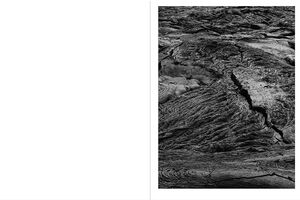Ron Jude – 12 Hz
12 Hz—the lowest sound threshold of human hearing—suggests imperceptible forces, from plate tectonics to the ocean tides, from cycles of growth and decay in the forest, to the incomprehensibility of geological spans of time. The photographs in Ron Jude’s 12 Hz allude to the ungraspable scale and veiled mechanics of these phenomena, while acknowledging a desire to gain a broader perspective, beyond the human enterprise, in a time of ecological and political crisis.
12 Hz consists of images of lava tubes and flows, tidal currents, glacial ice and welded tuff formations: pictures describing the raw materials of the planet, those that make organic life possible. The images were made in multiple locations – from the high lava plains, gorges and caves in the state of Oregon, to the glaciers of Iceland and lava flows of Kilauea in Hawaii.
Jude’s photographs don’t attempt to tell us how to live or what we’ve done wrong, nor do they reduce the landscape to something sentimental, tame and possessable. Rather, they endeavour to describe and reckon with forces in our physical world that operate independently of anthropocentric experience. The photographs in 12 Hz work in service to a simple premise: that change is constant, whether we are able to perceive it or not. By stepping back to look at the larger system of flux—of which we are only a small part—this book evokes us to find our own pulse, as it were, and assert an appropriately scaled sense of being within the hierarchy of this system.
12 Hz consists of images of lava tubes and flows, tidal currents, glacial ice and welded tuff formations: pictures describing the raw materials of the planet, those that make organic life possible. The images were made in multiple locations – from the high lava plains, gorges and caves in the state of Oregon, to the glaciers of Iceland and lava flows of Kilauea in Hawaii.
Jude’s photographs don’t attempt to tell us how to live or what we’ve done wrong, nor do they reduce the landscape to something sentimental, tame and possessable. Rather, they endeavour to describe and reckon with forces in our physical world that operate independently of anthropocentric experience. The photographs in 12 Hz work in service to a simple premise: that change is constant, whether we are able to perceive it or not. By stepping back to look at the larger system of flux—of which we are only a small part—this book evokes us to find our own pulse, as it were, and assert an appropriately scaled sense of being within the hierarchy of this system.
More books from Ron Jude view all






